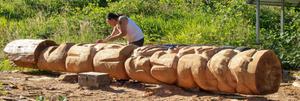By Floyd McKay
of Crosscut.com

James carving a totem pole as statement of protest to coal exporting at Cherry Point. Paul K. Anderson/Chuckanut Conservancy photo
Lummi master carver Jewell James is taking another ceremonial totem pole on a long trip, but this time it won’t be going as a healing pole — like those he carved for the three 9-11 sites — this pole is a political and cultural statement aimed at the export of coal from ports in the Pacific Northwest.
The pole is taking shape only a few miles from the proposed site of the largest coal terminal in the region, at Cherry Point north of Bellingham on Georgia Strait.
It’s a site that James and other Lummis regard as sacred; their ancestors lived, fished and died at Cherry Point through the centuries before white men discovered the area, imposed treaties on the natives and pushed them onto reservations.
The reservations are still there, as are the natives, and pressure continues to bring industry with its economic development, jobs, shipping, railroads, pollution, threats to native fishing areas and trampling of ancient grounds. Over the last two centuries, Cherry Point has seen two oil refineries, an aluminum plant and now plans for yet another giant industry.
Now, the Lummis appear to be well-positioned to play a key, perhaps the most critical role, in determining the fate of a huge proposal to export coal to China from Cherry Point.
(To read the full article, go to https://crosscut.com/2013/08/19/coal-ports/115987/mckay-lummi-corps/)
**If you are reading theOrcasonian for free, thank your fellow islanders. If you would like to support theOrcasonian CLICK HERE to set your modestly-priced, voluntary subscription. Otherwise, no worries; we’re happy to share with you.**








Thanks for the update about the totem carving by Jewell James. I read the original Crosscut article and am hopeful that the Lummi tribe may be able to stop the Cherry Point construction. I believe we should support the Lummi in their stance.